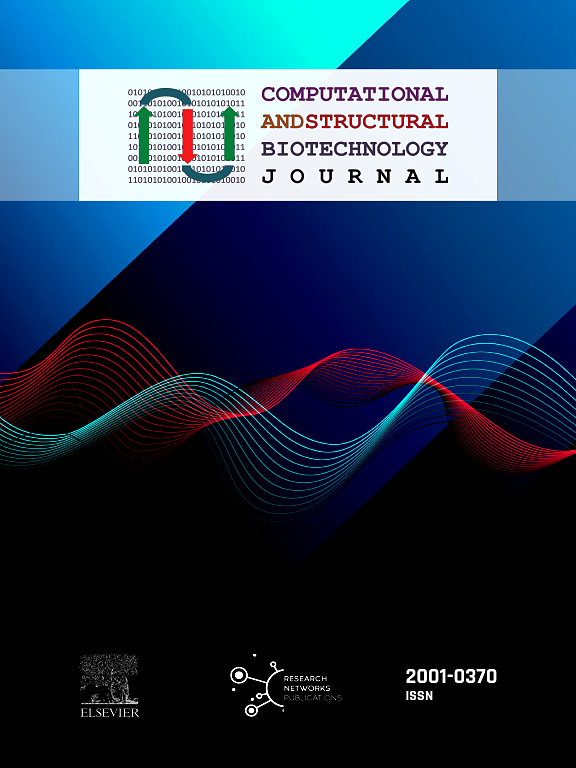Mime: A flexible machine-learning framework to construct and visualize models for clinical characteristics prediction and feature selection
IF 4.4
2区 生物学
Q2 BIOCHEMISTRY & MOLECULAR BIOLOGY
Computational and structural biotechnology journal
Pub Date : 2024-06-29
DOI:10.1016/j.csbj.2024.06.035
引用次数: 0
Abstract
The widespread use of high-throughput sequencing technologies has revolutionized the understanding of biology and cancer heterogeneity. Recently, several machine-learning models based on transcriptional data have been developed to accurately predict patients’ outcome and clinical response. However, an open-source R package covering state-of-the-art machine-learning algorithms for user-friendly access has yet to be developed. Thus, we proposed a flexible computational framework to construct a machine learning-based integration model with elegant performance (Mime). Mime streamlines the process of developing predictive models with high accuracy, leveraging complex datasets to identify critical genes associated with prognosis. An in silico combined model based on de novo PIEZO1-associated signatures constructed by Mime demonstrated high accuracy in predicting the outcomes of patients compared with other published models. Furthermore, the PIEZO1-associated signatures could also precisely infer immunotherapy response by applying different algorithms in Mime. Finally, SDC1 selected from the PIEZO1-associated signatures demonstrated high potential as a glioma target. Taken together, our package provides a user-friendly solution for constructing machine learning-based integration models and will be greatly expanded to provide valuable insights into current fields. The Mime package is available on GitHub ().

Mime:灵活的机器学习框架,用于构建和可视化临床特征预测和特征选择模型
高通量测序技术的广泛应用彻底改变了人们对生物学和癌症异质性的认识。最近,一些基于转录数据的机器学习模型被开发出来,用于准确预测患者的预后和临床反应。然而,目前尚未开发出一个开源的 R 软件包,它涵盖了最先进的机器学习算法,方便用户使用。因此,我们提出了一个灵活的计算框架,以构建一个基于机器学习、性能优雅的整合模型(Mime)。Mime 简化了开发高精度预测模型的过程,利用复杂的数据集来识别与预后相关的关键基因。与其他已发表的模型相比,Mime 构建的基于全新 PIEZO1 相关特征的硅学组合模型在预测患者预后方面表现出极高的准确性。此外,PIEZO1相关特征还能通过Mime中的不同算法精确推断免疫治疗反应。最后,从 PIEZO1 相关特征中筛选出的 SDC1 显示出作为胶质瘤靶点的巨大潜力。总之,我们的软件包为构建基于机器学习的整合模型提供了用户友好型解决方案,并将得到极大扩展,为当前领域提供有价值的见解。Mime 软件包可在 GitHub 上下载()。
本文章由计算机程序翻译,如有差异,请以英文原文为准。
求助全文
约1分钟内获得全文
求助全文
来源期刊

Computational and structural biotechnology journal
Biochemistry, Genetics and Molecular Biology-Biophysics
CiteScore
9.30
自引率
3.30%
发文量
540
审稿时长
6 weeks
期刊介绍:
Computational and Structural Biotechnology Journal (CSBJ) is an online gold open access journal publishing research articles and reviews after full peer review. All articles are published, without barriers to access, immediately upon acceptance. The journal places a strong emphasis on functional and mechanistic understanding of how molecular components in a biological process work together through the application of computational methods. Structural data may provide such insights, but they are not a pre-requisite for publication in the journal. Specific areas of interest include, but are not limited to:
Structure and function of proteins, nucleic acids and other macromolecules
Structure and function of multi-component complexes
Protein folding, processing and degradation
Enzymology
Computational and structural studies of plant systems
Microbial Informatics
Genomics
Proteomics
Metabolomics
Algorithms and Hypothesis in Bioinformatics
Mathematical and Theoretical Biology
Computational Chemistry and Drug Discovery
Microscopy and Molecular Imaging
Nanotechnology
Systems and Synthetic Biology
 求助内容:
求助内容: 应助结果提醒方式:
应助结果提醒方式:


